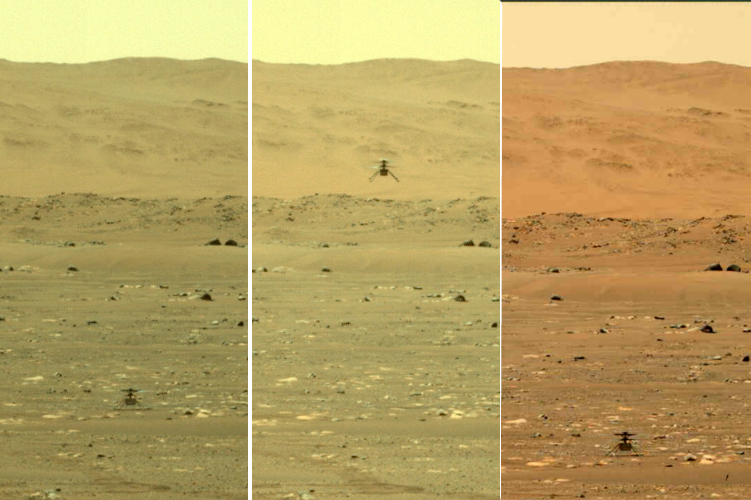Jupiter’s changing and unchanging Great Red Spot
In a paper published in March in the Journal of Geophysical Research: Planets, scientists (using images from amateurs, the Hubble Space Telescope, and Juno, scientists) have mapped out the interactions between Jupiter’s Great Red Spot, the longest known storm on the gas giant, and the smaller storms that interact with it as they zip past.
The series of images to the right come from figure 5 of their paper, showing the Spot over a period of three days. The Spot in these images is about 9,000 miles across, less than half the size it had been back in the late 1800s.
The black arrows mark the shifting location and shape of one smaller vortice as it flowed past the Spot from east to west along its northern perimeter, ripping off portions of the Spot as it passed. From the paper’s absract:
During its history, the [Great Red Spot] has shrunk to half its size since 1879, and encountered many smaller anticyclones and other dynamical features that interacted in a complex way. In 2018–2020, while having a historically small size, its structure and even its survival appeared to be threatened when a series of anticyclones moving in from the east tore off large fragments of the red area and distorted its shape. In this work, we report observations of the dynamics of these interactions and show that as a result the [Spot] increased its internal rotation velocity, maintaining its vorticity but decreasing its visible area, and suffering a transient change in its otherwise steady 90‐day oscillation in longitude.
…From the analysis of the reflectivity of the [Spot] and flakes and model simulations of the dynamics of the interactions we find that these events are likely to have been superficial, not affecting the full depth of the [Spot]. The interactions are not necessarily destructive but can transfer energy to the [Spot], maintaining it in a steady state and guaranteeing its long lifetime.
In other words, the changes seen only involved the Spot’s cloud tops, even if those tops were many miles thick. The storm itself is much deeper, with its base embedded strongly inside Jupiter and largely unaffected by these passing smaller storms.
Why the Spot exists and remains so long-lived remains an unsolved mystery.
In a paper published in March in the Journal of Geophysical Research: Planets, scientists (using images from amateurs, the Hubble Space Telescope, and Juno, scientists) have mapped out the interactions between Jupiter’s Great Red Spot, the longest known storm on the gas giant, and the smaller storms that interact with it as they zip past.
The series of images to the right come from figure 5 of their paper, showing the Spot over a period of three days. The Spot in these images is about 9,000 miles across, less than half the size it had been back in the late 1800s.
The black arrows mark the shifting location and shape of one smaller vortice as it flowed past the Spot from east to west along its northern perimeter, ripping off portions of the Spot as it passed. From the paper’s absract:
During its history, the [Great Red Spot] has shrunk to half its size since 1879, and encountered many smaller anticyclones and other dynamical features that interacted in a complex way. In 2018–2020, while having a historically small size, its structure and even its survival appeared to be threatened when a series of anticyclones moving in from the east tore off large fragments of the red area and distorted its shape. In this work, we report observations of the dynamics of these interactions and show that as a result the [Spot] increased its internal rotation velocity, maintaining its vorticity but decreasing its visible area, and suffering a transient change in its otherwise steady 90‐day oscillation in longitude.
…From the analysis of the reflectivity of the [Spot] and flakes and model simulations of the dynamics of the interactions we find that these events are likely to have been superficial, not affecting the full depth of the [Spot]. The interactions are not necessarily destructive but can transfer energy to the [Spot], maintaining it in a steady state and guaranteeing its long lifetime.
In other words, the changes seen only involved the Spot’s cloud tops, even if those tops were many miles thick. The storm itself is much deeper, with its base embedded strongly inside Jupiter and largely unaffected by these passing smaller storms.
Why the Spot exists and remains so long-lived remains an unsolved mystery.










